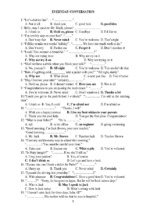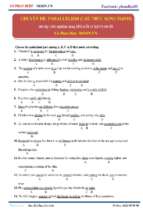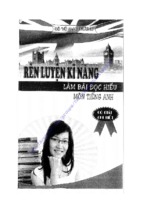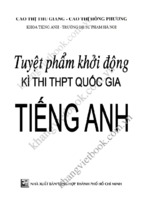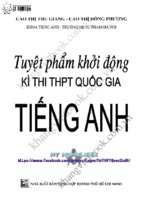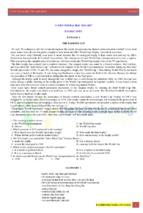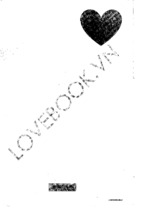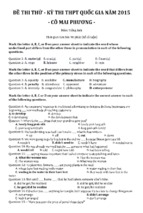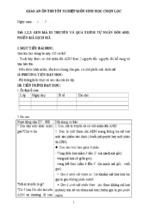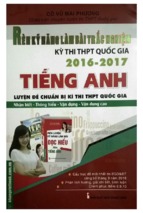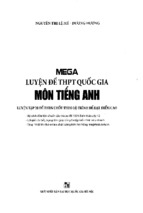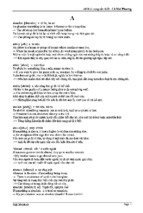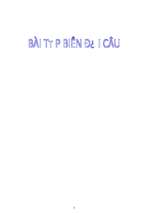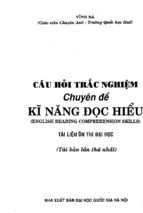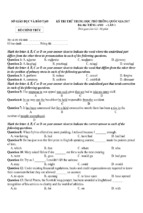Moon.vn
KHÓA HỌC: RÈN KỸ NĂNG ĐỌC HIỂU - CÔ MAI PHƢƠNG
Read the following passage and mark the letter A, B, C, or D on your answer sheet to indicate
the best answer to each of the following questions.
Television, like language, can be a cultural challenge for better or worse, and this is what it is in
many of its activities, whether voluntarily or, on occasion involuntarily. Although it may sometimes be
soothing, television is often provocative in the sense that it gives information and arouses interest. That being
said, the new means of broadcasting and communicating throughout the world increases the complexity of
television even further.
An important question is what television is there to do and to say. In actual fact, however, the issue
does not seem to have been put in this way by all governments and their officials, nor by private television
companies.
Since the primary aim is to get an audience (and who would want to make television programs
nobody looked at?), programs are becoming more and more standardized. The cultural challenge represented
by television must not turn into a challenge to culture. At all events, television carries massages which
influence, and will increasingly influence, trends in societies one way or another. Either television will
contribute to enriching our culture or to enabling some of these cultures to dominate others.
Undoubtedly there are outstanding events, such as broadcasts of major occasions, but the out-of-theordinary nature of a cultural message soon becomes part of life, part of the every air breathed by those to
whom the messages are sent. Living in a world of painting, literature and music is a very different thing from
the stardom of a composer, writer or performer. While the heads of television channels sometimes display
boldness, they do not seem to find it necessary to do so when it comes to music (with the occasional
exception), because they themselves are not convinced of the emotional impact of music on television. And
yet, in spite of all obstacles, music is a challenge through its daily presence. This represents a victory for
whom? Pure music – that is to say, music soberly presented through the playing of the performers – goes down
very well on the small screen. Its presence on television makes it part of everyday life.
Let us be optimistic and hope that those in charge of television of whatever kind are aware of the
importance of their function over and above audience surveys and ratings and that they will call primarily on
the talents of cultural people and give them priority over the salesman.
1. What is the effect of television according to the author?
A. It causes intellectual laziness
B. It makes the viewers think.
C. It is harmful to society.
D. It confuses the viewers.
2. Television’s function is to make people ___________.
Moon.vn
Hotline: 04.32.99.98.98
1
Moon.vn
KHÓA HỌC: RÈN KỸ NĂNG ĐỌC HIỂU - CÔ MAI PHƢƠNG
A. Confused of what is happening
B. More interested in what is happening
C. More culturally oriented
D. More educated in society
3. In the author’s opinion, what is wrong with the attitude of some governments to television?
A. They do not think it is important.
B. They do not pay enough attention to its function.
C. They do not use it effectively.
D. They have too much control over it.
4. The influence that television may have is possibly ______________.
A.
Ignored by almost everybody
B.
Greatly considered by governments
C.
A substantial benefit for private companies
D.
An enrichment and also a challenge to cultures
5. The author thinks that television programs are in danger of ____________.
A.
Trying to please too many people
B.
Preventing the development of society
C.
Losing their effect on our culture
D.
Declining in popularity
6. What are the heads of television not convinced of its impact?
A.
Music
B.
Literature
C.
Fine arts
D.
Painting
7. According to the author, the heads of the television channels____________.
A.
Have an adventurous approach to presenting music
B.
Broadcast only important musical events
C.
Do not think music is effective on television
D.
Do not want music to be part of everyday life
8. Music has become _____________.
A.
Very important to television program producers
B.
Very important to policy makers
C.
Part of the cultural message
D.
Part of daily life
9. What does the author hope will be the future of television?
A.
B.
C.
Moon.vn
More popular programs will be broadcast.
Television controllers will change their attitudes.
Audience will go on increasing.
Hotline: 04.32.99.98.98
2
Moon.vn
KHÓA HỌC: RÈN KỸ NĂNG ĐỌC HIỂU - CÔ MAI PHƢƠNG
D.
The right kind of program-makers will be appointed.
10. The best title for this passage is?
A.
B.
C.
D.
Television and its programs
The influence of televisions on governments and companies
The impact of television on culture
The standardization of television programs
1. What is the effect of television according to the author?
E.
It causes intellectual laziness
F.
It makes the viewers think.
G.
It is harmful to society.
H.
It confuses the viewers.
Giải thích: Theo tác giả ảnh hưởng của truyền hình là gì?
A. Nó gây ra sự lười suy nghĩ
B. Nó làm cho ngƣời xem phải suy nghĩ.
C. Nó có hại cho xã hội.
D. Nó gây bối rối cho người xem.
Thông tin ở đoạn sau:
“Although it may sometimes be soothing, television is often provocative in the sense that it gives
information and arouses interest. That being said, the new means of broadcasting and communicating
throughout the world increases the complexity of television even further.”
(Trong tất cả các sự kiện, truyền hình mang lại các thông điệp có ảnh hưởng và sẽ ngày càng gây
ảnh hưởng, các xu hướng trong xã hội theo cách này hoặc cách khác. Hoặc truyền hình sẽ đóng góp vào việc
cải thiện xã hội hoặc cho phép một số nền văn hóa chi phối các nền văn hóa khác.)
Bởi vì truyền hình mang lại cho người xem những thong điệp có sức ảnh hưởng nó làm cho
người xem phải suy nghĩ.
2. Television’s function is to make people ___________.
E.
Confused of what is happening
F.
More interested in what is happening
G.
More culturally oriented
H.
More educated in society
Giải thích: Chức năng của truyền hình là để làm cho mọi người ___________ .
Moon.vn
Hotline: 04.32.99.98.98
3
Moon.vn
KHÓA HỌC: RÈN KỸ NĂNG ĐỌC HIỂU - CÔ MAI PHƢƠNG
A. Nhầm lẫn về những gì đang xảy ra
B. Quan tâm đến những gì đang xảy ra
C. Có định hướng về văn hóa nhiều hơn
D. Có giáo dục trong xã hội
Thông tin ở đoạn sau: “Television, like language, can be a cultural challenge for better or worse,
and this is what it is in many of its activities, whether voluntarily or, on occasion involuntarily. Although it
may sometimes be soothing, television is often provocative in the sense that it gives information and arouses
interest.” (Truyền hình, giống như ngôn ngữ, có thể là một thử thách văn hóa cho những điều tốt đẹp hơn
hoặc tồi tệ hơn, và điều này nằm ở các hoạt động của nó, là tự nguyện hay là vô ý. Cho dù có lúc nhẹ nhàng,
nhưng truyền hình thường mang tính khiêu khích khi nó mang lại những thông tin và làm tăng niềm hứng
thú.)
3. In the author’s opinion, what is wrong with the attitude of some governments to television?
E.
They do not think it is important.
F.
They do not pay enough attention to its function.
G.
They do not use it effectively.
H.
They have too much control over it.
Giải thích: Theo ý kiến của tác giả, thái độ của một số chính phủ đối với truyền hình có gì sai?
A. Họ không nghĩ rằng nó quan trọng.
B. Họ không quan tâm đầy đủ đến chức năng của nó.
C. Họ không sử dụng nó một cách hiệu quả .
D. Họ kiểm soát nó quá nhiều.
Thông tin ở đoạn sau: “An important question is … by private television companies.” (Một câu hỏi
quan trọng là truyền hình làm gì và nói lên điều gì. Tuy nhiên, trên thực tế, vấn đề này không có vẻ được các
chính phủ và các quan chức hay các công ty truyền hình tư nhân nhìn nhận theo cách này.)
4. The influence that television may have is possibly ______________.
E.
Ignored by almost everybody
F.
Greatly considered by governments
G.
A substantial benefit for private companies
H.
An enrichment and also a challenge to cultures
Giải thích: Sự ảnh hưởng mà truyền hình có thể có thể ______________ .
A. Bị hầu hế mọi người phớt lờ
Moon.vn
Hotline: 04.32.99.98.98
4
Moon.vn
KHÓA HỌC: RÈN KỸ NĂNG ĐỌC HIỂU - CÔ MAI PHƢƠNG
B. Bị chính phủ xem xét
C. Một lợi ích đáng kể cho các công ty tư nhân
D. Cơ hội làm giàu và cũng là một thách thức đối với các nền văn hóa
Thông tin ở đoạn sau: “Since the primary aim is … cultures to dominate others.” (Vì mục tiêu hàng
đầu là thu hút khán giả (và làm gì có ai muốn làm ra những chương trình mà chẳng có ai xem?), các chương
trình ngày càng được tiêu chuẩn hóa. Những thử thách văn hóa không được truyền hình mô tả được không
được phép trở thành những thử thách thành văn hóa. Trong tất cả các sự kiện, truyền hình mang lại các thông
điệp có ảnh hưởng và sẽ ngày càng gây ảnh hưởng, các xu hướng trong xã hội theo cách này hoặc cách khác.
Hoặc truyền hình sẽ đóng góp vào việc cải thiện xã hội hoặc cho phép một số nền văn hóa chi phối các nền
văn hóa khác.)
5. The author thinks that television programs are in danger of ____________.
E.
Trying to please too many people
F.
Preventing the development of society
G.
Losing their effect on our culture
H.
Declining in popularity
Giải thích: Tác giả cho rằng các chương trình truyền hình đang có nguy cơ ____________ .
A. Cố gắng để làm hài lòng nhiều ngƣời
B. Ngăn chặn sự phát triển của xã hội
C. Mất tầm ảnh hưởng trong nền văn hóa của chúng ta
D. Giảm sự phổ biến
“Since the primary aim is to get an audience (and who would want to make television programs
nobody looked at?), programs are becoming more and more standardized.”
(Vì mục tiêu hàng đầu là thu hút khán giả (và làm gì có ai muốn làm ra những chương trình mà
chẳng có ai xem?), các chương trình ngày càng được tiêu chuẩn hóa.)
6. What are the heads of television not convinced of its impact?
E.
Music
F.
Literature
G.
Fine arts
H.
Painting
Giải thích: Những người đứng đầu của truyền hình không bị thuyết phục bởi tác động của cái gì?
A. Âm nhạc
Moon.vn
Hotline: 04.32.99.98.98
5
Moon.vn
KHÓA HỌC: RÈN KỸ NĂNG ĐỌC HIỂU - CÔ MAI PHƢƠNG
B. Văn học
C. Nghệ thuật chân chính
D. Hội họa
Thông tin ở đoạn sau: “While the heads of television channels sometimes display boldness, they do
not seem to find it necessary to do so when it comes to music (with the occasional exception), because they
themselves are not convinced of the emotional impact of music on television.”
(Trong khi những người đứng đầu của các kênh truyền hình đôi khi cho thấy sự táo bạo, họ có vẻ
thấy điều đó là không cần thiết đối với âm nhạc (với ngoại lệ thường xuyên), vì chính họ không tin vào những
tác động cảm xúc của âm nhạc với truyền hình.)
7. According to the author, the heads of the television channels____________.
E.
Have an adventurous approach to presenting music
F.
Broadcast only important musical events
G.
Do not think music is effective on television
H.
Do not want music to be part of everyday life
Giải thích: Theo tác giả, những người đứng đầu các kênh truyền hình __________.
A. Có phương pháp phát nhạc đầy mạo hiểm
B. Chỉ phát những sự kiện âm nhạc quan trọng
C. Không nghĩ rằng âm nhạc có hiệu quả trên truyền hình
D. Không muốn âm nhạc là một phần của cuộc sống hàng ngày
Thông tin ở đoạn sau: “While the heads of television channels sometimes display boldness, they do
not seem to find it necessary to do so when it comes to music (with the occasional exception), because they
themselves are not convinced of the emotional impact of music on television.”
(Trong khi những người đứng đầu của các kênh truyền hình đôi khi cho thấy sự táo bạo, họ có vẻ
thấy điều đó là không cần thiết đối với âm nhạc (với ngoại lệ thường xuyên), vì chính họ không tin vào những
tác động cảm xúc của âm nhạc với truyền hình.)
8. Music has become _____________.
E.
Very important to television program producers
F.
Very important to policy makers
G.
Part of the cultural message
H.
Part of daily life
Giải thích: Âm nhạc đã trở thành _____________ .
Moon.vn
Hotline: 04.32.99.98.98
6
Moon.vn
KHÓA HỌC: RÈN KỸ NĂNG ĐỌC HIỂU - CÔ MAI PHƢƠNG
A. Rất quan trọng đối với các nhà sản xuất chương trình truyền hình
B. Rất quan trọng cho các nhà hoạch định chính sách
C. Một phần của những thông điệp văn hóa
D. Một phần của cuộc sống hàng ngày
Thông tin ở đoạn sau: “Pure music – that is to say, music soberly presented through the playing of
the performers – goes down very well on the small screen. Its presence on television makes it part of
everyday life.”
(Âm nhạc thuần túy – nói là thế, âm nhạc phản ánh chân thực qua sự thể hiện của người biểu diễn –
đi xuống rõ tệt trên màn ảnh nhỏ. Sự xuất hiện của nó trên truyền hình khiến nó trở thành 1 phần của cuộc
sống.)
9. What does the author hope will be the future of television?
A.
More popular programs will be broadcast.
B.
Television controllers will change their attitudes.
C.
Audience will go on increasing.
D.
The right kind of program-makers will be appointed.
Giải thích: Tác giả hy vọng điều gì về tương lai của truyền hình?
A. các chương trình phổ biến khác sẽ được phát sóng.
B. Những người điều hành truyền hình sẽ thay đổi thái độ .
C. Khán giả sẽ tiếp tục gia tăng.
D. Những người làm chương trình sẽ được bổ nhiệm đúng đắn.
Thông tin ở đoạn sau: “Let us be optimistic … over the salesman.” (Chúng ta hãy lạc quan và tin
tưởng rằng những người có trách nhiệm trong ngành truyền hình ở bất cứ mảng nào sẽ nhận thức được tầm
quan trọng của vai trò của chúng vượt lên trên các điều tra và tỉ suất khán giả và họ sẽ kêu chiêu mộ được tài
năng của những người có văn hóa và ưu tiên họ hơn những người kinh doanh.)
10. The best title for this passage is?
E.
Television and its programs
F.
The influence of televisions on governments and companies
G.
The impact of television on culture
H.
The standardization of television programs
Giải thích: Nhan đề hay nhất cho đoạn văn này là gì?
A. Truyền hình và các chương trình truyền hình
Moon.vn
Hotline: 04.32.99.98.98
7
Moon.vn
KHÓA HỌC: RÈN KỸ NĂNG ĐỌC HIỂU - CÔ MAI PHƢƠNG
B. Sự ảnh hưởng của TV đối với các chính phủ và các công ty
C. Các tác động của truyền hình về văn hóa
D. Các tiêu chuẩn của chương trình truyền hình
Bài viết nói lên những tác động của truyền hình như một thử thách của nền văn hóa và nêu ra
những xu hướng tác động (nhẹ nhàng, khiêu khích, mang thông điệp, …), xu hướng làm truyền hình và hi
vọng của tác giả đối với chương trình truyền hình trong tương lai.
Dịch bài:
Truyền hình, giống như ngôn ngữ, có thể là một thử thách văn hóa cho những điều tốt đẹp hơn hoặc
tồi tệ hơn, và điều này nằm ở các hoạt động của nó, là tự nguyện hay là vô ý. Cho dù có lúc nhẹ nhàng, nhưng
truyền hình thường mang tính khiêu khích khi nó mang lại những thông tin và làm tăng niềm hứng thú. Có
thể nói là, phương thức phát sóng và giao tiếp mới trên khắp thế giới làm tăng thêm sự phức tạp của truyền
hình.
Một câu hỏi quan trọng là truyền hình làm gì và nói lên điều gì. Tuy nhiên, trên thực tế, vấn đề này
không có vẻ được các chính phủ và các quan chức hay các công ty truyền hình tư nhân nhìn nhận theo cách
này.
Vì mục tiêu hàng đầu là thu hút khán giả (và làm gì có ai muốn làm ra những chương trình mà
chẳng có ai xem?), các chương trình ngày càng được tiêu chuẩn hóa. Những thử thách văn hóa không được
truyền hình mô tả được không được phép trở thành những thử thách thành văn hóa. Trong tất cả các sự kiện,
truyền hình mang lại các thông điệp có ảnh hưởng và sẽ ngày càng gây ảnh hưởng, các xu hướng trong xã hội
theo cách này hoặc cách khác. Hoặc truyền hình sẽ đóng góp vào việc cải thiện xã hội hoặc cho phép một số
nền văn hóa chi phối các nền văn hóa khác.
Chắc chắn có những sự kiện nổi bật, chẳng hạn như chương trình phát sóng vào những dịp quan
trọng, nhưng bản chất bất thường của một thong điệp văn hóa sớm trở thành một phần của cuộc sống, một
phần của hơi thở từ những người gửi thông điệp đi. Sống trong thế giới hội họa, văn học và âm nhạc là những
trải nghiệm rất khác nhau đến từ những ngôi sao soạn nhạc, nhà văn hoặc người biểu diễn. Trong khi những
người đứng đầu của các kênh truyền hình đôi khi cho thấy sự táo bạo, họ có vẻ thấy điều đó là không cần
thiết đối với âm nhạc (với ngoại lệ thường xuyên), vì chính họ không tin vào những tác động cảm xúc của âm
nhạc với truyền hình. Và mặc cho tất cả rào cản, âm nhạc vẫn là một thử thách trong hiện tại. Điều này đại
diện cho sự thắng thế của ai? Âm nhạc thuần túy – nói là thế, âm nhạc phản ánh chân thực qua sự thể hiện của
người biểu diễn – đi xuống rõ rệt trên màn ảnh nhỏ. Sự xuất hiện của nó trên truyền hình khiến nó trở thành 1
phần của cuộc sống.
Chúng ta hãy lạc quan và tin tưởng rằng những người có trách nhiệm trong ngành truyền hình ở
bất cứ mảng nào sẽ nhận thức được tầm quan trọng của vai trò của chúng vượt lên trên các điều tra và tỉ suất
Moon.vn
Hotline: 04.32.99.98.98
8
Moon.vn
KHÓA HỌC: RÈN KỸ NĂNG ĐỌC HIỂU - CÔ MAI PHƢƠNG
khán giả và họ sẽ kêu chiêu mộ được tài năng của những người có văn hóa và ưu tiên họ hơn những người
kinh doanh.
Questions 46 - 55. Read the following passage and mark the letter A, B, C, or D on your answer
sheet to indicate the best answer to each of the following questions.
Animation traditionally is done by hand-drawing or painting successive frames of an object, each
slightly different than the preceding frame. In computer animation, although the computer may be the
one to draw the different frames, in most cases the artist will draw the beginning and ending frames
and the computer will produce the drawings between the first and the last drawing. This is generally
referred to as computer-assisted animation, because4 the computer is more of a helper than an
originator.
In full computer animation, complex mathematical formulas are used to produce the final sequence
of pictures. These formulas operate on extensive databases of numbers that define the objects in the
pictures as they exist in mathematical space. The database consists of endpoints, and color and
intensity information. Highly trained professionals are needed to produce such effects because
animation that obtains high degrees of realism involves computer techniques for three-dimensional
transformation, shading, and curvatures.
High-tech computer animation for film involves very expensive computer systems along with
special color terminals or frame buffers. The frame buffer is nothing more than a giant image memory
for viewing a single frame. It temporarily holds the image for display on the screen.
A camera can be used to film directly from the computer’s display screen, but for the highest
quality images possible, expensive film recorders are used. The computer computes the positions and
colors for the figures in the picture, and sends this information to the recorder, which captures it on
film. Sometimes, however, the images are stored on a large magnetic disk before being sent to the
recorder. Once this process is completed, it is repeated for the next frame. When the entire sequence
has been recorded on the film, the film must be developed before the animation can be viewed. It the
entire sequence does not seem right, the motions must be corrected, recomputed, redisplayed, and
rerecorded. This approach can be very expensive and time consuming. Often, computer-animation
companies first do motion tests with simple computer-generated line drawings before selling their
computers to the task of calculating the high-resolution, realistic-looking images.
1. What aspect of computer animation does the passage mainly discuss?
Moon.vn
Hotline: 04.32.99.98.98
9
Moon.vn
KHÓA HỌC: RÈN KỸ NĂNG ĐỌC HIỂU - CÔ MAI PHƢƠNG
A. The production process
B. The equipment needed
C. The high cost
D. The role of the artist
2. According to the passage, in computer-assisted animation the role of the computer is to draw the
_________.
A. first frame
B. middle frames
C. last frame
D. entire sequence of frames
3. The word “they” in the second paragraph refers to __________.
A. formulas
B. databases
C. numbers D. objects
4. According to the passage, the positions and colors of the figures in high-tech animation are
determined by ___________.
A. add color to the images
B. expose several frames at the same time
C. store individual images
D. create new frames
5. According to the passage, the positions and colors of the figures in high-tech animation are
determined by __________.
A. drawing several versions
B. enlarging one frame at a lime
C. analyzing the sequence from different angles
D. using computer calculations
6. The word “captures” in the fourth paragraph is closest in meaning to _________.
A. separates B. registers
C. describes D. numbers
7. The word “Once” in the fourth paragraph is closest in meaning to ___________.
A. before
B. since
C. after
D. while
8. According to the passage, how do computer-animation companies often test motion?
A. They experiment with computer-generated line drawings.
B. They hand-draw successive frames.
C. They calculate high-resolution images.
Moon.vn
Hotline: 04.32.99.98.98
10
Moon.vn
KHÓA HỌC: RÈN KỸ NĂNG ĐỌC HIỂU - CÔ MAI PHƢƠNG
D. They develop extensive mathematical formulas.
9. The word “task” in the fourth paragraph is closest in meaning to ___________.
A. possibility
B. position
C. time
D. job
10. Which of the following statements is supported by the passage?
A. Computers have reduced the costs of animation.
B. In the future, traditional artists will no longer be needed.
C. Artists are unable to produce drawings as high in quality as computer drawings.
D. Animation involves a wide range of technical and artistic skills.
Questions 46 - 55. Read the following passage and mark the letter A, B, C, or D on your answer
sheet to indicate the best answer to each of the following questions.
1. What aspect of computer animation does the passage mainly discuss?
A. The production process
B. The equipment needed
C. The high cost
D. The role of the artist
Giải thích: Bài khóa chủ yếu thảo luận về khía cạnh nào của việc sản xuất phim hoạt hình trên máy
tính?
A. Quá trình sản xuất
B. Các thiết bị cần thiết
C. Chi phí cao
D. Vai trò của các họa sĩ
Bài khóa đề cập đến quá trình sản xuất phim hoạt hình trên máy tình từ những khâu vẽ bằng tay ban
đầu đến quá trình chỉnh sửa và cơ chế hoạt động của máy tính trong các quá trình đó.
2. According to the passage, in computer-assisted animation the role of the computer is to draw the
_________.
A. first frame
B. middle frames
C. last frame
D. entire sequence of frames
Giải thích: Theo đoạn văn, trong phim hoạt hình do máy tính hỗ trợ vai trò của máy tính là vẽ
_________ .
Moon.vn
Hotline: 04.32.99.98.98
11
Moon.vn
KHÓA HỌC: RÈN KỸ NĂNG ĐỌC HIỂU - CÔ MAI PHƢƠNG
A. khung đầu
B. khung giữa
C. khung cuối
D. toàn bộ chuỗi khung
Thông tin ở đoạn sau: “.In computer animation, although the computer may be the one to draw the
different frames, in most cases the artist will draw the beginning and ending frames and the computer
will produce the drawings between the first and the last drawing.” ( Trong việc làm hoạt hình trên máy
tính, dù máy tính có thể vẽ các mảng hình khác nhau, nhưng hầu như người nghệ sĩ sẽ vẽ mảng hình
đầu tiên và cuối cùng và máy tính sẽ sản xuất ra các hình vẽ giữa phần đầu và phần cuối.)
3. The word “they” in the second paragraph refers to __________.
A. formulas
B. databases
C. numbers
D. Objects
Giải thích: Từ "they" trong đoạn thứ hai đề cập đến __________ .
A. công thức B. cơ sở dữ liệu
C. những con số
D. các vật thể
Thông tin ở đoạn sau: “These formulas operate on extensive databases of numbers that define the
objects in the pictures as they exist in mathematical space.” (Những công thức này dựa trên các cơ sở
dữ liệu mở rộng của các con số mà định các vật thể trên các bức tranh khi chúng tồn tại trong không
gian toán học.)
Đại từ “they” thay thế cho “objects” phía trước.
4. According to the passage, the frame buffer mentioned in the first paragraph is used to
___________.
A. add color to the images
B. expose several frames at the same time
C. store individual images
D. create new frames
Giải thích: Theo bài khóa, bộ đệm khung được nhắc đến trong đoạn 1 được dung để _______.
A. thêm màu sắc cho hình ảnh
B. chiếu một vài khung hình cùng một lúc
C. lƣu trữ từng hình ảnh một
D. tạo khung hình mới
Thông tin ở đoạn sau: “The frame buffer is nothing more than a giant image memory for viewing a
single frame. It temporarily holds the image for display on the screen.” (Thiết bị đệm hình ảnh không
là gì khác ngoài một bộ nhớ hình ảnh khổng lồ để quan sát một mảng hình. Nó giữ cho hình ảnh tạm
thời hiện lên trên màn hình.)
5. According to the passage, the positions and colors of the figures in high-tech animation are
determined by __________.
Moon.vn
Hotline: 04.32.99.98.98
12
Moon.vn
KHÓA HỌC: RÈN KỸ NĂNG ĐỌC HIỂU - CÔ MAI PHƢƠNG
A. drawing several versions
B. enlarging one frame at a lime
C. analyzing the sequence from different angles
D. using computer calculations
Giải thích: Theo đoạn văn, vị trí và màu sắc của các nhân vật trong phim hoạt hình công nghệ cao
được xác định bằng cách __________ .
A. vẽ ra một số phiên bản
B. mở rộng khung hình
C. phân tích trình tự từ các góc độ khác nhau
D. sử dụng các phép tính toán trên máy tính
Dẫn chứng: “In full computer animation, complex mathematical formulas are used to produce the final
sequence of pictures. These formulas operate on extensive databases of numbers that define the objects
in the pictures as they exist in mathematical space.”
(Trong việc làm phim hoạt hình trên máy tính đầy đủ, những công thức toán học phức tạp được sử
dụng để sản xuất các chuỗi thức của hình ảnh. Những công thức này dựa trên các cơ sở dữ liệu mở
rộng của các con số mà định các vật thể trên các bức tranh khi chúng tồn tại trong không gian toán
học.)
6. The word “captures” in the fourth paragraph is closest in meaning to _________.
A. separates
B. registers
C. describes
D. Numbers
Giải thích: Từ “captures” ở đoạn 4 gần nghĩa nhất với _____________.
Ta có: (to) capture = (to) register: bắt lại, ghi lại
Các đáp án còn lại:
(to) separate: tách ra
(to) describe: mô tả
(to) number: đánh số
7. The word “Once” in the fourth paragraph is closest in meaning to ___________.
A. before
Moon.vn
B. since
C. after
Hotline: 04.32.99.98.98
13
D. While
Moon.vn
KHÓA HỌC: RÈN KỸ NĂNG ĐỌC HIỂU - CÔ MAI PHƢƠNG
Giải thích: Từ “once” ở đoạn 4 gần nghĩa nhất với _____________.
Trong ngữ cảnh này, ta nên hiểu: Once = after (conj): sau khi
“Once this process is completed, it is repeated for the next frame.”
(Sau khi quá trình này đã hoàn tất, nó sẽ lặp đi lặp lại trong khung hình tiếp theo.)
Các đáp án còn lại:
Before (conj): trước, trước khi
Since (conj): kế từ khi
While (conj): trong khi
8. According to the passage, how do computer-animation companies often test motion?
A. They experiment with computer-generated line drawings.
B. They hand-draw successive frames.
C. They calculate high-resolution images.
D. They develop extensive mathematical formulas.
Giải thích: Theo đoạn văn, các công ty làm phim hoạt hình trên máy tính thường xuyên kiểm tra
chuyển động như thế nào?
A. Họ thử nghiệm với bản vẽ do máy tính tạo ra.
B. Họ vẽ tay ở những khung hình kế tiếp.
C. Họ tính toán các hình ảnh có độ phân giải cao.
D. Họ phát triển các công thức toán học rộng.
Thông tin ở đoạn sau: “Often, computer-animation companies first do motion tests with simple
computer-generated line drawings before selling their computers to the task of calculating the highresolution, realistic-looking images.”
(Thường thì, các công ty sản xuất hoạt hình trên máy tính ban đầu thực hiện kiểm tra chuyển động
bằng các bản vẽ phác sơ lược bằng máy tính trước khi chuyển máy của họ sang khâu tính toán phân
giải cao, các hình ảnh nhìn chân thật.)
9. The word “task” in the fourth paragraph is closest in meaning to ___________.
A. possibility
Moon.vn
B. position
C. time
Hotline: 04.32.99.98.98
14
D. Job
Moon.vn
KHÓA HỌC: RÈN KỸ NĂNG ĐỌC HIỂU - CÔ MAI PHƢƠNG
Giải thích: Từ “task” ở đoạn 4 gần nghĩa nhất với _____________.
Ta có: task = job (n): công việc, nhiệm vụ
Các đáp án còn lại:
Possibility (n): khả năng
Position (n): vị trí, địa vị
Time (n): thời gian
10. Which of the following statements is supported by the passage?
A. Computers have reduced the costs of animation.
B. In the future, traditional artists will no longer be needed.
C. Artists are unable to produce drawings as high in quality as computer drawings.
D. Animation involves a wide range of technical and artistic skills.
Giải thích: Khẳng định nào sau đây đúng với đoạn văn?
A. Máy tính đã làm giảm chi phí của hoạt hình.
B. Trong tương lai, các họa sĩ truyền thống sẽ không còn cần thiết.
C. Các họa sỹ là không thể tạo ra các bản vẽ chất lượng cao như những bản vẽ máy tính.
D. Việc sản xuất phim hoạt hình liên quan đến một loạt cáckỹ năng về kỹ thuật và nghệ thuật.
Dù không khẳng định trực tiếp trong bài nhưng chúng ta đều thấy việc sản xuất phim hoạt hình là một
công việc khó khan gồm nhiều công đoạn, vì vậy nó đòi hỏi cao về kỳ xảo và nghệ thuật.
Dịch bài:
Việc sản xuất phim hoạt hình truyền thống được thực hiện bằng vẽ tay hoặc bằng các mảng hình
vẽ hoàn chỉnh của một vật thể, mà mỗi một mảng hình vẽ này lại khác biệt với mảng hình trước đó.
Trong việc sản xuất hoạt hình trên máy tính, dù máy tính có thể vẽ các mảng hình khác nhau, nhưng
hầu như người nghệ sĩ sẽ vẽ mảng hình đầu tiên và cuối cùng và máy tính sẽ sản xuất ra các hình vẽ
giữa phần đầu và phần cuối. Đây được xem như cách sản xuất hoạt hình với sự hỗ trợ trên máy tính, vì
máy tính giúp ích nhiều hơn thay vì là cái mở đầu.
Trong việc làm phim hoạt hình trên máy tính đầy đủ, công thức toán học phức tạp được sử dụng
để sản xuất các chuỗi thức của hình ảnh. Những công thức này dựa trên các cơ sở dữ liệu mở rộng của
Moon.vn
Hotline: 04.32.99.98.98
15
Moon.vn
KHÓA HỌC: RÈN KỸ NĂNG ĐỌC HIỂU - CÔ MAI PHƢƠNG
các con số mà định các vật thể trên các bức tranh khi chúng tồn tại trong không gian toán học. Cơ sở
dữ liệu bao gồm các thiết bị cuối, màu sắc và cường độ thông tin. Các chuyên gia được có trình độ cao
rất cần thiết trong việc tạo ra hiệu ứng như vậy vì hình ảnh động có mức độ chân thực cao liên quan
đến kỹ thuật máy tính để chuyển đổi ba chiều, tạo bóng, và độ cong.
Máy tính sản xuất hoạt hình công nghệ cao gồm các hệ thống máy tính đắt tiền cùng với các
thiết bị phối màu sắc đặc biệt hoặc các thiết bị đệm hình ảnh. Thiết bị đệm hình ảnh không là gì khác
ngoài một bộ nhớ hình ảnh khổng lồ để quan sát một mảng hình. Nó giữ cho hình ảnh tạm thời hiện lên
trên màn hình.
Một camera có thể được sử dụng để quay phim trực tiếp từ màn hình hiển thị của máy tính,
nhưng đối với những hình ảnh chất lượng cao nhất có thể, thiết bị quay phim đắt tiền sẽ được sử dụng.
Các máy tính sẽ tính toán các vị trí và màu sắc cho các con số trong hình, và gửi thông tin này đến các
máy ghi đã ghi nó lại trên phim. Tuy nhiên, đôi khi, những hình ảnh được lưu trữ trên đĩa từ loại lớn
trước khi được gửi đến máy ghi. Sau khi quá trình này đã hoàn tất, nó sẽ lặp đi lặp lại trong khung
hình tiếp theo. Khi toàn bộ trình tự đã được ghi lại trên phim, bộ phim phải được xây dựng trước có thể
xem những hình ảnh động. Khi bộ chuỗi có vẻ không đúng, các phía chuyển động phải được chỉnh sửa,
tính toán lại, hiển thị lại, và ghi lại. Phương pháp này có thể rất tốn kém và mất thời gian. Thường thì,
các công ty sản xuất hoạt hình trên máy tính ban đầu thực hiện kiểm tra chuyển động bằng các bản vẽ
phác sơ lược bằng máy tính trước khi chuyển máy của họ sang khâu tính toán phân giải cao, các hình
ảnh nhìn chân thật.
Questions 56 - 65. Read the following passage and mark the letter A, B, C, or D on your answer
sheet to indicate the best answer to each of the following questions.
Color in textiles is produced by dyeing, by printing, or by painting. Until the nineteenth century,
all dyes were derived from vegetable or, more rarely, animal or mineral sources. Since madder plants
could be grown practically everywhere, the roots of some species of the madder plant family were used
from the earliest period to produce a whole range of reds. Red animal dyes, derived from certain species
of scale insects, were also highly value from ancient times through the Middle Ages. Blues were
obtained from woad, a plant common in Europe and also used in the Near East from the beginning of
the Christian era. Before the first, nonfading “solid” green was invented in early nineteenth century,
greens were achieved by the overdyeing or overpriting of yellow and blue. However, yellow dyes,
whether from weld or some other plant sources such as saffron or turmeric, invariably fade or
disappear. This accounts for the bluish tinge of what were once bright greens in, for example, women
tapestry.
Moon.vn
Hotline: 04.32.99.98.98
16
Moon.vn
KHÓA HỌC: RÈN KỸ NĂNG ĐỌC HIỂU - CÔ MAI PHƢƠNG
The range of natural colors was hugely expanded and, indeed, superseded by the chemical dyes
developed during the eighteen hundreds. By 1900, a complete range of synthetic colors had been
evolved, many of which reached a standard of resistance to fading from exposure to light and to
washing that greatly exceeded that of natural dyestuffs. Since then, petroleum industry has added many
new chemicals, and from these, other types of dyestuffs have been developed. Much of the research in
dyes was stimulated by the peculiarities of some of the new synthetic fibers- Acetate rayon, for
example, seemed at first to have no affinity for dyes and a new range of dyes had to be developed;
nylon and Terylene presented similar problems.
The printing of textiles has involved a number of distinct methods. With the exception of printing
patterns directly onto the cloth, whether by block, roller, or screen, all of these are based on dyeing; that
is, immersion of the fabric in a dye bath.
1. The passage mainly discusses the __________ .
A. Development of synthetic colors for texiles during the nineteenth century.
B. Advantages of chemical dyes over dyes derived from plants and animals
C. Differences between dyeing texibles and printing items
D. History of the use of natural and chemical dyes to color texiles
2. According to the passage, what was the source of most textile dyes that were used before the
nineteenth century?
A. Animals
B. Minerals
C. Plants
D. Chemicals
3. What was the advantage of using madder plants for different shades of red?
A. It was possible to cultivate madder plants in almost every location.
B. Madder plants produced brighter colors than other plant sources.
C. Plant sources produced more lasting colors than other plant sources.
D. Dyes derived from the madder plants were easier to work with than other dyes.
Moon.vn
Hotline: 04.32.99.98.98
17
Moon.vn
KHÓA HỌC: RÈN KỸ NĂNG ĐỌC HIỂU - CÔ MAI PHƢƠNG
4. One disaddvantage of green dyes before the nineteenth centure was ___________.
A. The yallow dyes were expensive
B. They lost their original color
C. The blue dyes involved lost their color
D. The final color varied
5. The green areas in women tapestries developed a bluish tige because ___________.
A. A darker color, like blue, dominates a light color, like yellow
B. Light changed some of the green dye used in the tapestries to blue
C. The yellow dye that was used in the tapestries had faded
D. The dyes used to color woven tapestries were made from minerals
6. Red dyes came mostly from ___________.
A. Animals
B. Plants and insects
C. Indigo
D. Minerals
7. How did chemacal dyes compare to natural dyes?
A. The chemical dyes had less attractive colors.
B. The chemical dyes were less easy to use
C. The chemical dyes lost their brightness more quickly when exposed to light.
D. The chemical dyes held up better after washing.
8. The chemical dyes keep color because they are less prone to _____________.
A. sunshine
B. wind
C. restriction
D. wear
Moon.vn
Hotline: 04.32.99.98.98
18
Moon.vn
KHÓA HỌC: RÈN KỸ NĂNG ĐỌC HIỂU - CÔ MAI PHƢƠNG
9. According to the passage, what problem led to the development of the new dyes after 1900?
A. Previously developed dyes did not work on new types of fibers
B. Dyes derived from petroleum caused damage to new synthetic fibers
C. New synthetic fibers lost required brighter colors than natural fibers did.
D. New fabrics easily lost their colors when washed.
10. What does the author mean by “block, roller, or screen”?
A. To give examples of textile printing techniques that are based on dyeing.
B. To argue that all methods printing patterns onto textiles involve dyeing.
C. To emphasize the variety of special tools used the process of dyeing textiles.
D. To give examples of textile priting techniques that do not involve dyeing.
. Questions 56 - 65. Read the following passage and mark the letter A, B, C, or D on your answer
sheet to indicate the best answer to each of the following questions.
1. The passage mainly discusses the __________ .
A. Development of synthetic colors for texiles during the nineteenth century.
B. Advantages of chemical dyes over dyes derived from plants and animals
C. Differences between dyeing texibles and printing items
D. History of the use of natural and chemical dyes to color texiles
Giải thích: Đoạn văn chủ yếu thảo luận về __________ .
A. Sự phát triển màu tổng hợp cho dệt may trong thế kỷ XIX .
B. Ưu điểm của thuốc nhuộm hóa học so với thuốc nhuộm có nguồn gốc từ thực vật và động vật
C. Sự khác biệt giữa hàng dệt may được nhuộm và các hang được in.
D. Lịch sử của việc sử dụng thuốc nhuộm tự nhiên và hóa học để tạo màu cho đồ dệt may.
Đoạn văn đề cập đến sự ra đời, nguồn gốc tự nhiên, sự phát triển của các loại thuốc nhuộm ban đầu và
những ưu nhược điểm của chúng để dẫn đến sự ra đời của thuốc nhuôn hóa học.
Moon.vn
Hotline: 04.32.99.98.98
19
Moon.vn
KHÓA HỌC: RÈN KỸ NĂNG ĐỌC HIỂU - CÔ MAI PHƢƠNG
2. According to the passage, what was the source of most textile dyes that were used before the
nineteenth century?
A. Animals
B. Minerals
C. Plants
D. Chemicals
Giải thích: Theo đoạn văn, nguồn gốc của hầu hết các loại thuốc nhuộm được sử dụng trước khi thế kỷ
XIX là gì?
A. Động vật
B. Khoáng sản
C. Thực vật
D. Hóa chất
Thông tin ở đoạn sau: “Until the nineteenth century, all dyes were derived from vegetable or, more
rarely, animal or mineral sources.”
(Cho đến thế kỉ 19, tất cả các thuốc nhuộm được chiết xuất từ thực vật hoặc ít thông dụng hơn là từ
động vật và các nguồn khoáng chất. )
3. What was the advantage of using madder plants for different shades of red?
A. It was possible to cultivate madder plants in almost every location.
B. Madder plants produced brighter colors than other plant sources.
C. Plant sources produced more lasting colors than other plant sources.
D. Dyes derived from the madder plants were easier to work with than other dyes.
Giải thích: Lợi thế của việc sử dụng các cây thiên thảo làm các tong màu đỏ khác nhau là gì?
A. Có thể trồng cây thiên thảo ở hầu hết mọi nơi.
B. Cây thiên thảo tạo ra màu sắc tươi sáng hơn so với các loài thực vật khác.
C. Thực vật tạo ra màu sắc bền hơn so với những nguồn thực vật khác .
D. Thuốc nhuộm có nguồn gốc từ cây thiên thảo là dễ xử lý hơn những thuốc nhuộm khác.
Moon.vn
Hotline: 04.32.99.98.98
20
- Xem thêm -

